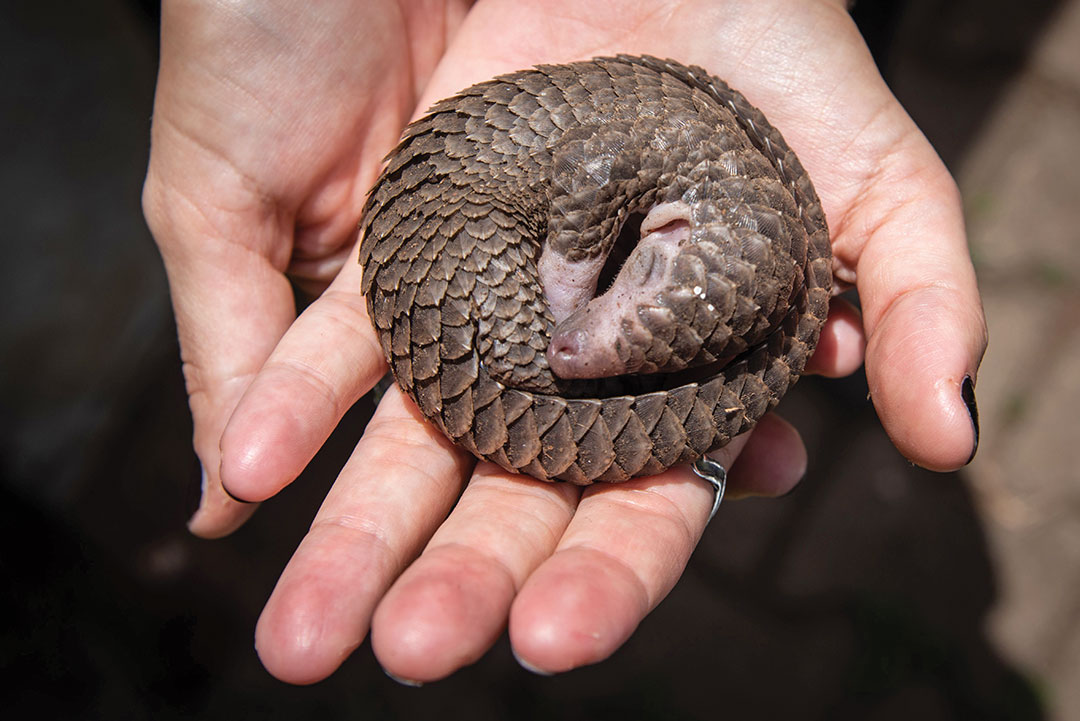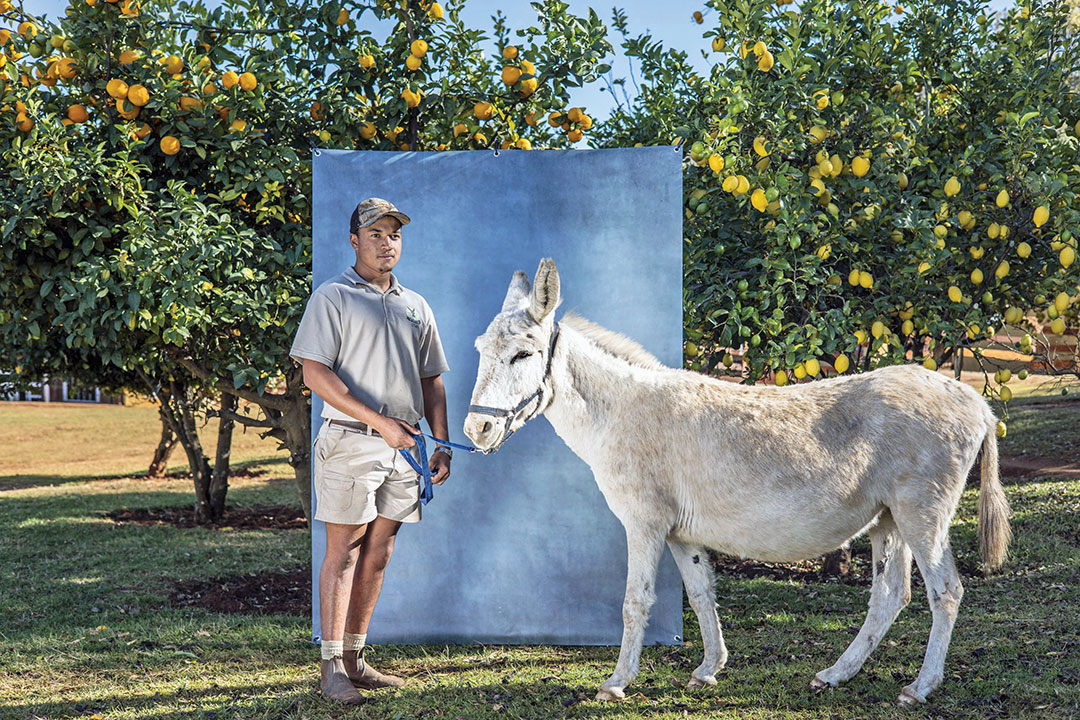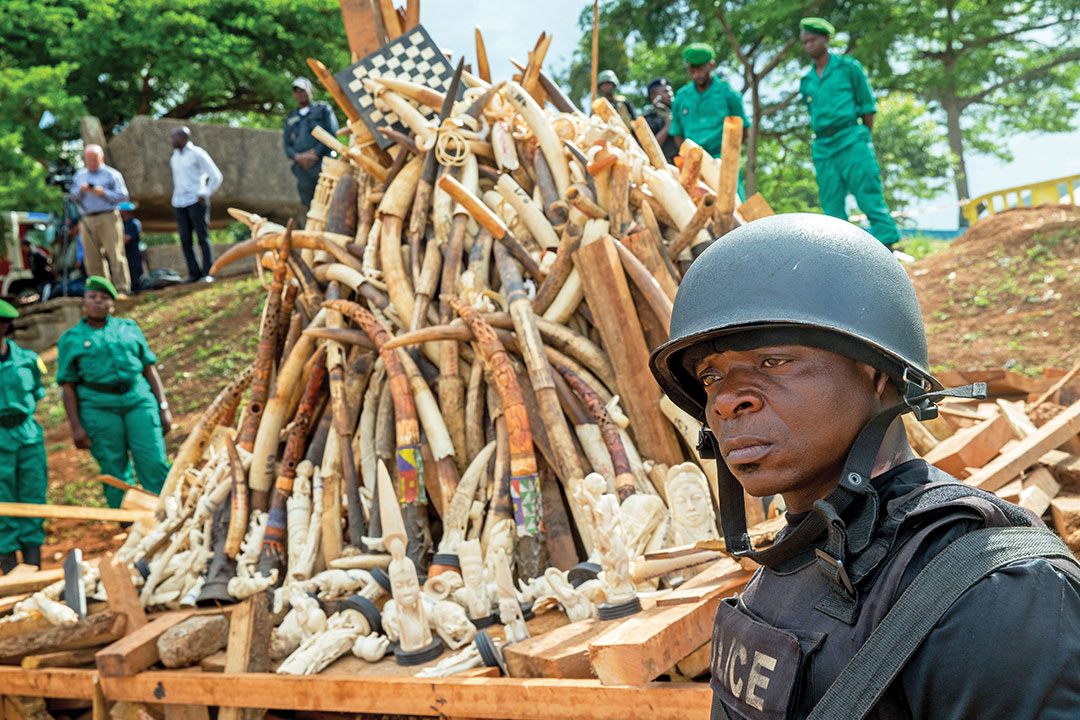ADF STAFF
For years, the Democratic Republic of the Congo (DRC) has been plagued by international gangs slaughtering and selling parts from endangered animals.
“The DRC, which shares borders with nine countries, serves as an important transit point for the movement of trafficked parts,” the environmental news agency Mongabay reported in 2022. “The Central African nation, which hosts the largest swath of Congo Basin rainforest, is also a source country for illegal wildlife goods.”
In one case, authorities conducted investigations for three years before raiding a “stash house” in the city of Lubumbashi, seizing 2 metric tons of ivory valued at $6 million.
Authorities in the raid said the tusks came from more than 150 elephants. The three people arrested in May 2022 were believed to be members of a major wildlife trafficking ring operating throughout Southern Africa, according to Mongabay.

Five months later, security agents arrested two men while authorities seized $3.5 million worth of ivory, rhino horn and pangolin scales that had originated in the DRC. The men acknowledged that, from November 2019 through June 2021, they had shipped 22 kilograms of ivory from Kinshasa by cutting the tusks into smaller pieces, painting them black and labeling them as wood, The Associated Press reported.
Elephant tusks, rhino horns, pangolin scales and even donkey skins are hot commodities in Asia, chiefly in China. The tusks are carved into elaborate, expensive ornaments and jewelry, and the horns, scales and skins are used in traditional Chinese medicine (TCM). The demand for donkey skins alone in Asia is estimated at 5 million per year. None of these organic materials is traded legally.
Criminal groups build up stockpiles in the DRC while plotting ways to move them out of the country. The environmental investigative group Oxpeckers says that what happens to seized ivory and other goods generally is unknown. DRC environmentalist Josué Aruna says such seized goods are “likely to return to the black market,” because authorities don’t disclose what they have done with them. During a Conference of the Parties for the Convention on International Trade in Endangered Species of Wild Fauna and Flora (CITES) in 2019, officials said they were “aware of a number of thefts of ivory from government-held stockpiles in recent years.”
Such illegal trade comes at a tremendous cost. Endangered animals are slaughtered, and hundreds of wildlife rangers have been murdered in the line of duty. The smuggling comes at the cost of good local governance, community stability and regional security.
The money from the trade also funds extremist groups. As Humane Society International notes, several African militia groups “have engaged in elephant poaching and used profits from [the] sale of the ivory to fund their terrorist activities.”
Countries throughout Africa struggle with handling and storing confiscated ivory and rhino horns. The conservation charity Traffic, in a report released in 2020, noted that “One of the known sources of illegal ivory is leakage from government held stockpiles.” Traffic has noted that confiscated ivory and rhino horns can end up stored in banks, patrol posts, customs offices, courts and tribunals, police stations, and other agencies. Oxpeckers reported that such agencies typically can keep the goods for an unlimited amount of time, and stocks are not inventoried.

PROTECTING A STOCKPILE
Even when confiscated ivory and other goods don’t return to the black market, the problem remains of what to do with them. Zimbabwe, home to the world’s second-largest population of elephants after Botswana, has a stockpile of confiscated ivory and rhino horns worth $600 million. Storage of the 130 metric tons of ivory and 6 to 7 metric tons of rhino horn is an expensive security problem because of the volume of the material.
Zimbabwe wants to sell the confiscated ivory and rhino horn to help finance the protection of the country’s wildlife. The TRT Afrika digital channel reports that the Zimbabwe Parks and Wildlife Authority has been struggling due to financial constraints in recent years. The authority is not included in the national budget and independently needs at least $20 million annually to pay for its conservation work. The authority needs more patrol cars, surveillance drones and personnel.
Zimbabwe has been asking for the sale for two years. So far, the answer has been no.
In 1989, CITES banned the sale of ivory. At first, the ban worked, and demand for ivory in parts of the world dropped to a historic low. Humane Society International noted that “illegal trade was severely curbed and ivory carving factories in China and shops in Hong Kong closed down.” But in 1999, CITES approved a one-time sale of nearly 50 metric tons of stockpiled ivory from Botswana, Namibia and Zimbabwe to Japan. That triggered a renewed interest in ivory, and from January 2000 to June 2002, more than 1,000 African elephants were found dead, killed for their tusks.
In 2008, again with the approval of CITES, Botswana, Namibia, South Africa and Zimbabwe exported 102 metric tons of government stockpiled ivory to Japan and China. Humane Society International said the sale triggered more African elephant massacres.
The society maintains that to save elephants, the sale of ivory must be illegal, with no exceptions for legal sales from stockpiles. More than 20 countries throughout the world have determined that the only sure way to keep confiscated ivory and rhino horn off the market is to destroy it, usually by burning or crushing.
Kenya was the first country to do a public burning in 1989. At that time, Paul Udoto, a Kenyan Wildlife Service spokesman, said the historic burn was a “desperate measure meant to send a message to the world about the destruction through poaching of Kenya’s elephants,” the Tsavo Trust, a conservation organization, later reported. Burning ivory is not an easy task: It takes about a week to burn an average male elephant tusk.
Conservationists and governments that support destroying confiscated goods say that the practice builds public support for the protection of endangered animals and sends a message to poachers that their work is immoral and futile. Critics say the practice not only may increase poaching by creating a perception of scarcity on the black market, but also deprives countries of the opportunity to make millions of dollars from their work stopping smugglers.

TCM SPREADS TO AFRICA
The practice of using such things as rhino horns, pangolin scales and tiger parts in TCM goes back centuries. The animal ingredients are worthless in treating medical conditions, but their use is so prevalent in TCM, some of the creatures have become endangered. So many Asian pangolins have been slaughtered that smugglers have moved on to capturing African pangolins.
The African Wildlife Foundation reports that poachers kill about 2.7 million African pangolins each year, making them the most trafficked mammal in the world. The scales are used in TCM to treat a variety of conditions, including arthritis and cancer. The scales are made of keratin, the same material in human fingernails.
“The level at which pangolins are being trafficked is huge compared to what it has been in the past,” said Sarah Stoner of the Wildlife Justice Commission in 2020, as reported by National Geographic magazine. “It’s on a completely different level.”
The situation will get worse. China’s Belt and Road Initiative, which is financing infrastructure all over the world, has a stated goal of spreading TCM. The Environmental Investigation Agency says that “major companies and countless clinics have already been established across the continent and certain retailers plan to establish full supply chains in place, from sourcing to sales.”
“Our very real concern is that such a huge expansion of TCM in Africa, as is happening under China’s Belt and Road initiative, will have the knock-on effect of drastically increasing demand for treatments containing wildlife,” the agency reported. It “is a prescription for disaster for some endangered animal species, such as leopards, pangolins and rhinos.”

STOPPING THE TRAFFICKING
Conservationists and animal protection advocates say that more work is needed to stop the illegal sale of endangered animals and prevent confiscated materials from creeping back into the black market. The African Wildlife Foundation says that all controls on animal parts marketing begin with a three-pronged strategy: “Stop the killing, stop the trafficking and stop the demand.”
The Environmental Investigation Agency has a plan to stop the ivory trade, but it also would apply, in part, to other forms of animal trafficking. The plan includes disrupting criminal networks through undercover investigations, working to close all ivory markets, exposing the global hub of the illegal ivory trade, dismantling ivory trafficking syndicates and continuing to push for international laws that ban such sales.
Other agencies and experts have recommended these steps for stopping the black market sale of animal parts:
Increase protection for threatened species. Malawi is using affordable technology such as surveillance drones to support rangers as they try to protect wildlife.
Encourage tourism. Investing in infrastructure so tourists can visit wildlife preserves can be a financial windfall. In addition to tourism revenue, camera-toting tourists can deter would-be poachers. Countries such as Botswana that have a strong conservation focus attract tourists who are eager to see rhinos, elephants and other animals.
Partner with civil society groups. Governments have had success working with charities and environmental groups that protect endangered species. Such public-private efforts can pressure destination countries to strengthen enforcement.
Aggressively prosecute wildlife traffickers. “Coordinating cross-border investigations and amassing the necessary evidence is tricky,” reports Mongabay. “Wildlife crimes are often not prioritized by law enforcement agencies or judicial authorities.” Other experts say that prosecution can only be as good as the integrity of courts systems and the professionalism in processing evidence. The advocacy group Wildlife concluded: “Corruption and/or a lack of adequate law enforcement allows organized crime and terrorism to gain a foothold in some countries and fuels the ivory trade.”

